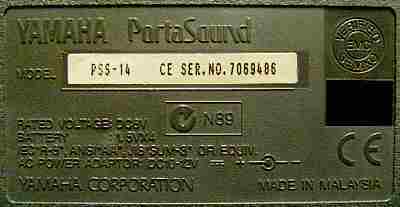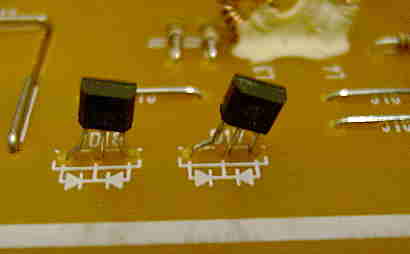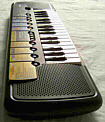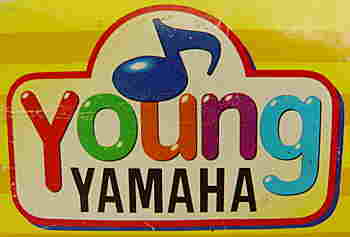| Yamaha
PSS-7 |
|
pretty wavetable toy keyboard with unusual granular sounds |
PSS-14
Yamaha PSS-7
This small "Young Yamaha" toy PortaSound from 1997 is possibly
not the best sounding, but at least the prettiest of all Yamaha
keyboards. It makes a lot of great granular tekkno noises including a quite
unique sounding lo-fi keyboard drum kit mode. All sounds are made from
wavetable synthesis based on low resolution samples.
main features:
-
32 mini keys (black keys are flimsy and may crack off easily when accidentally
bent upward)
-
small built-in speaker (sounds thin)
-
main voice polyphony 2 notes (and 4 for rhythm/ accompaniment)
-
100 preset sounds divided into 3 groups with 1*5 and 2*10 sounds and each
4 variants per sound selected by a variation button:
-
"i1" = combo {piano, e guitar, saxophone, e bass, percussion}
-
"i2" = keyboard {e piano, harpsichord, organ, clavi, accordion}, strings
{f guitar, violin, strings, harp, banjo}
-
"i3" = wind {trumpet, flute, harmonica, vibraphone, marimba}, effects {pig,
cat, telephone, tv game, chorus}
(More than half of the variations are short tone sequences or effects.)
-
30 preset rhythms ("bands", containing accompaniment) selected by 3 group
buttons:
-
"b1" = cool {Top 10, Video Pop, House, Reggae, Jazz}, hot {Rock, Funk,
Bossa Nova, Salsa, Surf}
-
"b2" = classics {Music Box, Gymnopedies, Für Elise, Siciliana, Polovtsian},
favorites {Musical, Merry- Go- Round, Pop Ballad, Lullaby, Waltz}
-
"b3" = showtime {Comic Dancer, Space Fantasy, Entertainer, Mambo, Lovely
Alien}, funtime {Horror, Spy, Fanfare, Safari, Carnival}
(Only very few are usable for making music, since they contain a very
stubborn fixed- key accompaniment and thus are rather monotos by themselves.)
-
tempo +/- buttons (16 steps) + "tap" button for intuitively tempo entry
-
volume +/- buttons (16 steps, reduce bit resolution badly)
-
"AWM" wavetable sound generator which uses many tricks with low- res samples
and employs partly very complex algorithmic volume and pitch envelopes.
E.g. the "cat" sound sounds really robotic because it is made of a sequence
of many short waveform sample fragments. The sounds contain a small dose
of aliasing noise.
-
CPU "Yamaha YMW-716C-D" (28 pin DIL | GEW11, crystal clocked @ 8 MHz)
-
10 demo songs (nicely instrumented, but unfortunately most are quite short)
-
jacks for 9V AC adapter (polarity protected) & headphone/ line out
jack
notes:
All button presses either play the selected sound or a low knocking bongo
noise at maximum volume (not very loud). When batteries run empty, the
instrument resets/ stutters as soon buttons are pressed, and due to the
instrument starts always with a fanfare at the loudest setting and plays
that loud bongo by pressing the volume buttons, this makes it sometimes
impossible to turn it quieter before it freaks out. I tried to add electrolytic
capacitors etc. to fix this but had no success.
Although it is nothing really great, this instrument contains many strange
lo-fi sounds and preset sound patterns those can be interesting for tekkno.
E.g. the very robotic animal voices (cat, dog, pig, cow) sound wonderfully
synthetic, and also the noisy (Fairlight- style) low- res sample
choir (called "chorus") sounds nice. There is a drum kit mode with very
synthetic tekkno cymbals (made from a short looped semi- metallic waveform
with decay envelope) and a strange snare that resembles a typewriter. When
2 keys are pressed with short delay, the drums make a great phasing effect.
The ringing mandolin ("f guitar" 2) makes every 0.5s a rhythmical short
pause. Some sound variations include an echo effect and there are many
strange monotos (melody loops) those can be melodically played on the keys
and some of them are well usable for tekkno. E.g. "tv game" 3 is a gritty
falling pitch glissando siren, and there are even 3 drum patterns those
can be rhythmically played on the keys (same note pitch). But unlike the
echo on the predecessor Yamaha PSS-6
here the main voice preset sounds ignore the tempo setting. The timbres
are a little rough; especially the plain squarewave tone "tv game" reveals
in high notes noticeable aliasing noise.
(The full sound set list can be found in the manual of this instrument,
downloadable on the Yamaha Manual
Library site.)
The internal fixed- key accompaniments otherwise doodle so stubborn
that besides "safari" they are of almost no use for playing any real music
on it. I really miss a sort-of long "space bar" key below the entire keyboard
to switch between main voice and chord mode during play, or at least some
user preset functions, but however, the thing is just a toy and was likely
simply invented to let kids improvise to a given background monoto for
learning to play/ tinkle together with a virtual band and get the feeling
for triggering preset patterns to a preset accompaniment rather than playing
own music on it. The access to the sounds is also everything but OBS; group
buttons need to be pressed multiple times while the actual sound is played
by each of these button presses - this makes sound switching during live
music performance almost impossible. Despite all this the PSS-7 is a quite
inspiring thing with many unusual sounds. Interesting is that the squarewave
preset sound is called "tv game" here, and there is also a style "video
pop" that reminds to a typical jingling NES or GameBoy background
music; this proves how much the unforgettable sound of historical videogames
has already found its way into the mainstream.
The 10 demo melodies are:
-
Mickey Mouse March
-
Little Brown Jug
-
Mission Impossible
-
Chopsticks
-
Jingle Bells
-
Pop Goes the Weasel
-
Gallant Pig
-
Awarding an Honor
-
Kissing Santa Claus
-
Over the Rainbow [very bluesy]
Most demos are extremely short, and there is not much difference between
these and the "bands" (accompaniments), of those many also constitute monotos
(repeating short melody loops) except that the demos mute their main voice
when the player plays to them on the keyboard.
A 4 note polyphonic midsize version of the PSS-7 was released as Yamaha
PSS-14 and PSS-15; beside it has 2 different demos, it behaves
identical. Due to the PSS-7 has a diodeless keyboard matrix (with narrow
and difficult to modify carbon trace contacts on the very small main PCB),
its CPU would be anyway incapable to sense more than 2 simultaneous key
presses without problems. Due to there are 18 places unoccupied in the
keyboard matrix, I initially thought that the PSS-14 would have exactly
the same CPU with a diode equipped matrix and an additional diode somewhere
to tell the CPU to activate the 4 note polyphonic mode. But I didn't found
out how to activate this mode and there also seem to be no other keyboard
matrix eastereggs. Later someone told me that his PSS-14 has a slightly
differently labelled CPU "YMW 716D-D"; I am not sure if it is just a different
revision number or if this causes the polyphony difference. Later I bought
my own PSS-14, which turned out to have yet another CPU and also 2 different
demos.
The direct predecessor of the PSS-7 was the Yamaha
PSS-6. Strange is that despite it is older, it had a way higher
sample quality and 15 very long and complex orchestrated demo melodies
(but it sounds also more establishment and has no great tekkno noises);
likely the resolution was reduced because Yamaha eliminated the separate
ROM IC (found in PSS-6) to cut down the costs. Another nice tekkno mini-
keyboard with wavetable sounds is the Casio
SA-5 (and its better midsize variant SA-35).
Yamaha PSS-14
This tablehooter from 1997 is the midsize version of the pretty Yamaha
PSS-7 mini keyboard. Unlike the latter it is now 4 note polyphonic,
has 2 tinny speakers and some different demos, but the rest is identical.
It was also released with silver control panel as Yamaha PSS-15.
different main features:
-
32 midsize keys
-
2 speakers (those sound very thin, hollow and have an unpleasant midrange
resonance)
-
main voice polyphony 4 notes (only 2 with accompaniment)
-
different CPU "Yamaha YMW716B-D, 9729 FADE, Japan" (28 pin DIL)
-
2 changed demos

The control panel shows many comic style icons. |
 |
 |
 |
modifications:
-
polarity protection diode added.
notes:
The speakers of this tablehooter roar unpleasantly hollow and make not
really more bass than the tiny Yamaha PSS-7. Generally this instrument
plays louder than the PSS-7, which makes the button press bongo noises
(those knock at full volume) already a bit unpleasant, although the normal
sound can be set low enough. There is also some beeping static keyboard
matrix noise present in the sound ( independent from the volume setting).
Also here the black keys have no protection against bending upward, but
at least they are less flimsy. The stylish control panel is labelled slightly
differently; it has e.g. more names and less icons, "Polovtsian" is called
here "Stranger", "Comic Dancer" = "Comic Panther", "F Guitar" = "folk guitar"
etc. But as well the sound & rhythm bank itself as the low sample resolution
are identical with the Yamaha PSS-7, thus its only technical improvement
is the 4 note polyphonic main voice sound, which is also nice to rhythmically
improvise with the many strange percussion and note sequence preset sounds
of this instrument; the rhythm sequences (drum patterns) e.g. make nice
phasing effects when played on multiple keys simultaneously.
 Technically
unusual is that the hardware design abuses transistors instead of keyboard
matrix diodes (1 transistor replaces 2 connected diodes) to reduce the
part count. This keyboard also had no polarity protection diode anymore;
most older Yamaha instruments have one. (Only my fullsize
Yamaha
DJX MIDI keyboard also lacks it.) The CPU here is a "Yamaha YMW716B-D";
someone told me by e-mail that his Yamaha PSS-14 had a "YMW 716D-D"
CPU instead. Technically
unusual is that the hardware design abuses transistors instead of keyboard
matrix diodes (1 transistor replaces 2 connected diodes) to reduce the
part count. This keyboard also had no polarity protection diode anymore;
most older Yamaha instruments have one. (Only my fullsize
Yamaha
DJX MIDI keyboard also lacks it.) The CPU here is a "Yamaha YMW716B-D";
someone told me by e-mail that his Yamaha PSS-14 had a "YMW 716D-D"
CPU instead. |
The 10 demo melodies are:
-
Wannabe [= pop song "Do You Wannabe My Lover?"]
-
Mickey Mouse March
-
Happy Birthday to You [with glissando]
-
Chopsticks
-
I Saw Mommy Kissing Santa Claus
-
Pop Goes the Weasel
-
Gallant Pig
-
Awarding an Honor
-
Mission Impossible
-
Over the Rainbow [very bluesy]
The melodies "Little Brown Jug" and "Jingle Bells" of the PSS-7 here
have been replaced with "Wannabe" and "Happy Birthday to You", but the
arrangement of the rest seems to be the same, thus most are still way too
short.
| removal
of these screws voids warranty... |
|
|
 |

|
|
| |
back
|
|














